Link acquisition is, in addition to working on content, one of the basic tasks when positioning your website. In the process, not only do we have to search for new places from which to acquire links, but we also have to constantly analyze and fight against competitors who are also positioning their sites.
Many questions arise here:
-
- What links matter?
.
-
- Can I acquire links like my competitors?
.
-
- Can I squeeze more out of my current links?
.
-
- In addition to publicly available link sources, should I look for alternative sources that my competitors do not have access to?
.
-
- What parameters are important for link selection? Is topicality important?
.
-
- When acquiring links to a site, can I harm my site? How to avoid it?
.
-
- Is it worth acquiring foreign links if my site only works locally? Can it help me? Or will it hurt?
.
-
- If links are so important, why optimize the site and do SEO audits?
.
The questions will multiply in direct proportion to the size of the project and the amount of money you want to spend on links.
Here I would like to invite you into the fascinating world of links – starting with the basics and ending with sample processes and decisions to be made.
Let’s get started!.
What are backlinks?
.
Backlinks, or external links, are links placed on other websites that point back to our website. External links can be natural (users place them themselves on other sites) or acquired by us (e.g., by purchasing or “encouraging” a publisher/webmaster/user to link to our site).
There are a number of link acquisition techniques that vary in effectiveness due to the time or financial investment required to do so. In fact, the biggest problem in link acquisition is cost. This cost depends on:
-
- The expectations of the site owner – everyone has some minimum they require for embedding a link to your site.
.
-
- Margin of the intermediary – the intermediaries available on the market add a “fee” for contacting and communicating with the publisher.
.
-
- Time required for acquisition – the more you have to nag to acquire a link, the more it costs you. The time cost indicator is particularly important for teams at SEO agencies, where the agency’s profits depend primarily on the efficiency of the working time. In this way, you can also count the cost of creating an SEO/PBN backend – the more time a specialist needs to build it, the more money it theoretically costs you to link.
.
Why links are important?
.
There are several reasons why acquiring backlinks to a site matters.
Prominent among them are:
-
- Their significant role in the operation of the Page Rank mechanism. Based on them, Google can judge the value of a landing page. They constitute something like votes, which are not equivalent in themselves, but they build the value of the landing page.
.
- They facilitate the detection of new content on the Internet. However, this does not mean that the content will be indexed. According to new information from Google employee John Mueller, a site must deserve to be in the index.
- Trend generation – if there starts to be a lot of mentions and links on a given topic, Google can react faster and adjust its search results to meet users’ needs.
- They naturally complement other online activities. If you promote your product in other channels, the result is almost always inquiries from users who share links about your offer.
The time outlay in working on optimizing your site (content, action) versus acquiring links varies, of course, depending on the industry you are in. It is never a 50/50 split – in the case of large sites with history (operating in the market “forever”), this split will turn more towards technical optimization.
In the case of a new site that has just started to build trust in the eyes of a search engine – link acquisition is one of the biggest and most important activities in SEO.
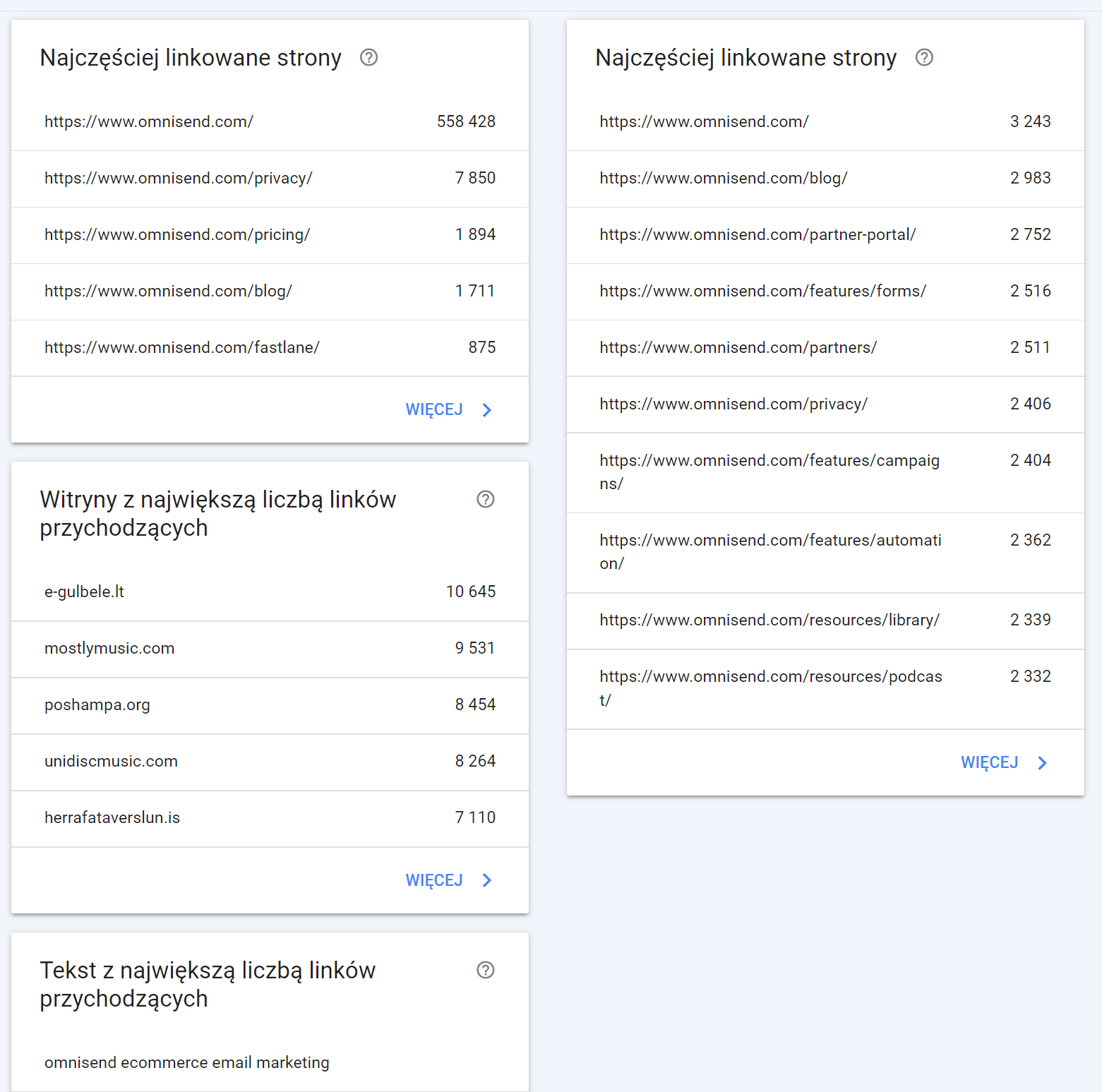 .
.
Can you make a good living without link acquisition?
.
No. ???? In the past, Google and Yandex have tried to find an alternative to links as a site rating element, while no meaningful results have been obtained in this regard.
The eternal war: white-hat & black-hat SEO
.
The topic of what’s white-hat and what’s black-hat in linkbuilding drastically changed its direction after 2016. That’s when Google implemented the so-called Real-time Penguin into its algorithm.
Theoretically, this change was supposed to allow faster evaluation and taking of activity
against webmasters “flying the coop” in terms of link acquisition. At the same time, it was reported that the search engine can decide on its own whether a link should harm or help your site.
This introduced another complexity: the necessity of verifying that links sourced to a site have SEO value and are not toxic.
In addition, the 2016 change significantly slows down how quickly link acquisition translates into site growth.
For the purposes of this post, I won’t delineate methods by color, as this is a subjective thing. I would only like to emphasize that any link acquisition activity may be judged negatively by Google in the future – as has happened in the past (the case of flowers sent to bloggers in exchange for a link and a mention to the site). Each reader must answer to himself how much he is willing to risk and how quickly he would like to “drive” his site into the TOP 10. Many times the shade of the chosen method is also determined by the budget and available time to achieve results.
SEO Optimization – an ally of strong links to the site
.
If one accepts the analogy that links are the fuel to drive the engine of our website, then optimization is the tuning to extract as much of the power as possible.
In addition to matching content to user queries and considering the relationship between keywords, an extremely important aspect is internal linking. In recent years, it’s safe to say that it’s the holy grail in optimizing any website.
Skillfully implemented (or automated) internal linking allows you to distribute the acquired link power between subpages. For this reason, it is important to ensure that each sub-page to which we acquire or receive (naturally) links has references to other important parts on the site.
Typical types of links to a site
.
Dofollow links, nofollow links (and more)
.
In the process of link acquisition, we aim to acquire links that convey SEO value. Possible attributes of each link:
-
- Dofollow links – that is, those that convey SEO power. This is the type of link that every SEO specialist should strive to acquire.
.
-
- nofollow links – are now only a suggestion to Google, which means that those who in the past acquired nofollow links as part of diversifying and unnaturalising their link profile can now gain. At the same time, further gradation of each link’s attributes has been introduced. Google has asked publishers/webmasters to label external links that appear on their sites as follows:
> Rel=”sponsored” – any outbound links that are paid (i.e., the advertiser has paid for such a link to be there). In the ideal world that Google dreams of, every purchased link should be described like this.
> Rel=”ugc” – outbound links, located in the forum or comments section.
> Mixed variant – a combination of, for example, ugc and nofollow – separated by a comma or space.
- nofollow links – are now only a suggestion to Google, which means that those who in the past acquired nofollow links as part of diversifying and unnaturalising their link profile can now gain. At the same time, further gradation of each link’s attributes has been introduced. Google has asked publishers/webmasters to label external links that appear on their sites as follows:
.
Google mentions in its documentation that it usually does not track these links.
Is it worth it to diversify the type of links acquired to a site? This is a complex topic. Many theories assume that in order to keep the link profile natural, it is good to acquire nofollow links from time to time. Unfortunately – there is no clear evidence that the once popular theory is justified after 2016.
Paid and free links
.
Nowadays, this kind of division does not work, because there are very few publicly available sites for acquiring links to a site that do not charge a fee for publication.
Moreover, in the proper accounting of linkbuilding work, the concept of a free link does not exist, because the cost of time always arises.
Does it make sense to acquire free links?” In my opinion, not necessarily.
Nowadays, free link placements are primarily intended to “boost” the parameters of the site they are directing to (e.g., the DR index from Ahrefs). Their real translation into position is negligible – probably because there are many other outbound links (sometimes to competitors as well) in the immediate vicinity of the link.
Anchor text in linking
.
Anchor text is a word or keywords that describe the link referring to our site. We distinguish the following types of anchor text:
-
- money keyword – the keyword on which we position our site
.
-
- brand – for example, the name of our company
.
-
- compound – a combination of brand and money keyword
.
- naked URL – a situation in which the link text is also a link to the page.
Important: In the case of obtaining links to a page in graphic form (link from an image) – the link text in this situation is the content of the alt text (alternative text).
Why do we need to know what types of anchor texts there are?
For the sake of “naturalness”. ???? Mentioned in the section on dofollow and nofollow links, it is only here that it makes real sense, because it allows you to easily assess whether a profile is natural or not.
It is assumed that in the process of link acquisition, the typical user does not know what anchor text is, so when placing a reference to your www on another site he will probably paste the link as it flies, i.e. he will use a naked URL. Consequently, a natural link profile overwhelmingly has links acquired as a naked URL, surrounded by a related keyword (e.g., a SXO audit of a site https://rogala.pro). When I work with clients to acquire links to a site, I aim for at least 50-70% of all links to the site to be just naked URLs. The remaining 30% gives me the opportunity to optimize and leverage links typically created with SEO in mind (i.e., PBNs/SEO links, for example).
History of anchor text in a nutshell – an SEO perspective
.
The topic of how to describe a link to a page is very complex. First of all, in the past, when manual penalties for link acquisition were a fact of life, it was the distribution of anchor texts/anchor texts that was one of the elements that influenced whether or not you received a penalty.
During the ordering of links to a site and the process of removing/revoking a penalty for backlinks, this was one of the main elements from which one started to evaluate the link profile.
A while back, there was a need for diversification, i.e. mass linking to “neutral” anchors of the type:
- click
- here
- see
etc.
In practice, this was still suspect. The whole thing led to linking on the so-called naked URL – that is, simply placing links to the target/positioned page.
At this point we are going through a renaissance of exact match linking – for the specific phrases we link to. This is due to the fact that most SEO professionals have stopped linking to “hard” phrases, which puts Google’s search engine vigilance to sleep a bit.
Important: Each link touchdown should be approached individually, especially since the rules of the game like to change. What is available and works today may not necessarily work tomorrow.
How to check your website links? Review existing backlinks
.
Checking what links currently lead to our site or to a competitor’s site is one of the basic tasks when assessing the competitiveness of a query or planning the budget needed for SEO. Knowing when and what links have been added to a site and comparing it with the visibility graph allows us to at least partially assess the time and money investment needed to get the organic traffic we are interested in.
There are many tools on the market that allow us to assess what links are currently leading to us.
Free tools that deserve our attention and should be included in our toolbox:
Google Search Console – Links report, in which we will get information on the number of external links and internal links (remember what I still wrote about the Holy Grail? ;)).
The whole thing is divided into three parts:
-
- Most linked pages – sub-pages on our site with the most external links reported in Google Search Console.
.
- Sites with the most inbound links – a list of domains that have been reported in Google Search Console as a source of links to our domain in the greatest number.
- Text with the highest number of inbound links.
- Text with the most inbound links – a report of link texts within the links acquired/received. Here we can get a quick overview of how many and which links were described by a specific type of anchor text.
 .
.
The report is very simple and does not give us information about the SEO parameters of each link, but only data on what subpage the links are pointing to and how many of them are there (and from how many domains):
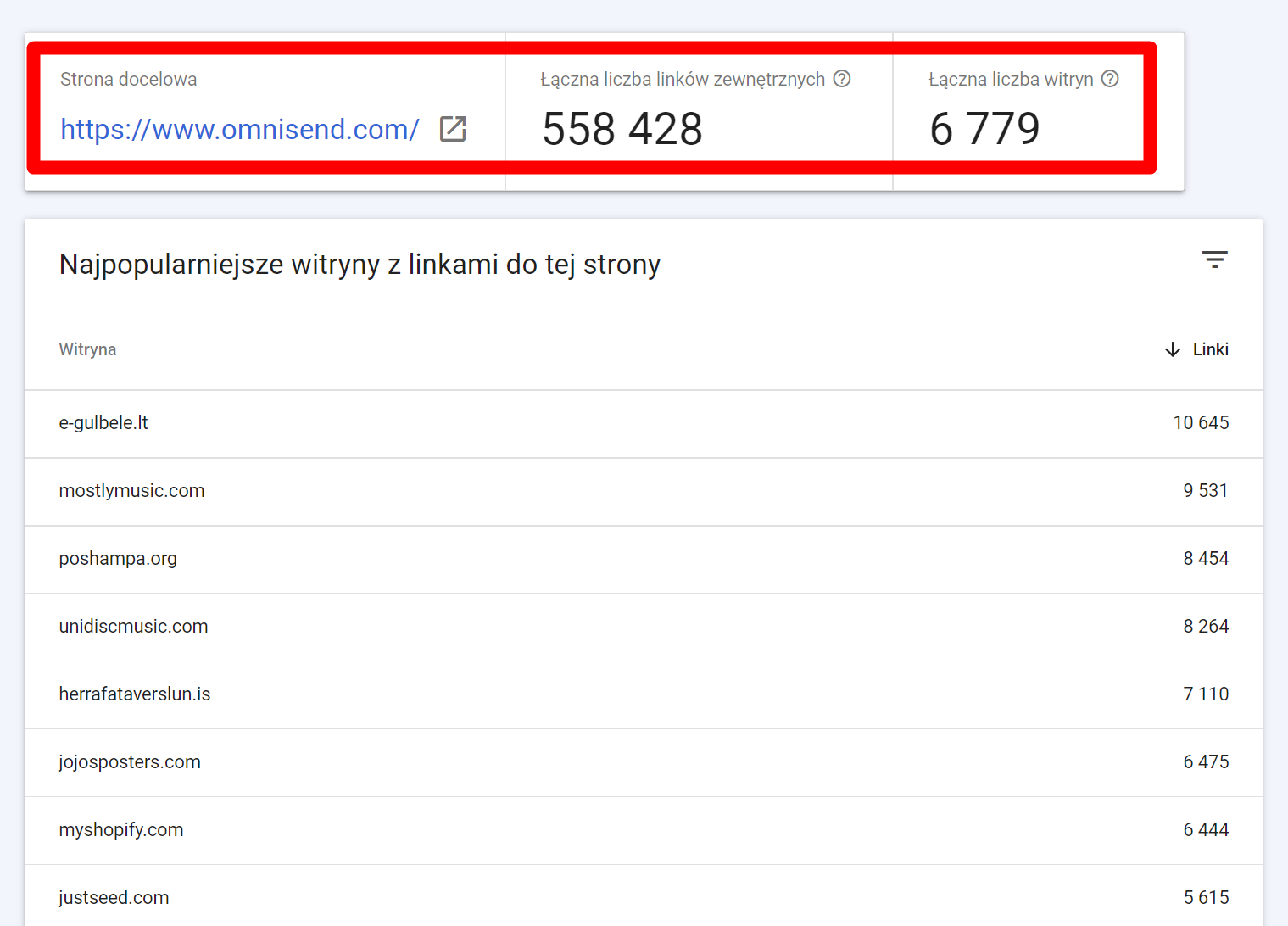
It is also possible to check this from the other side – that is, to see which domain and how many links to our website:
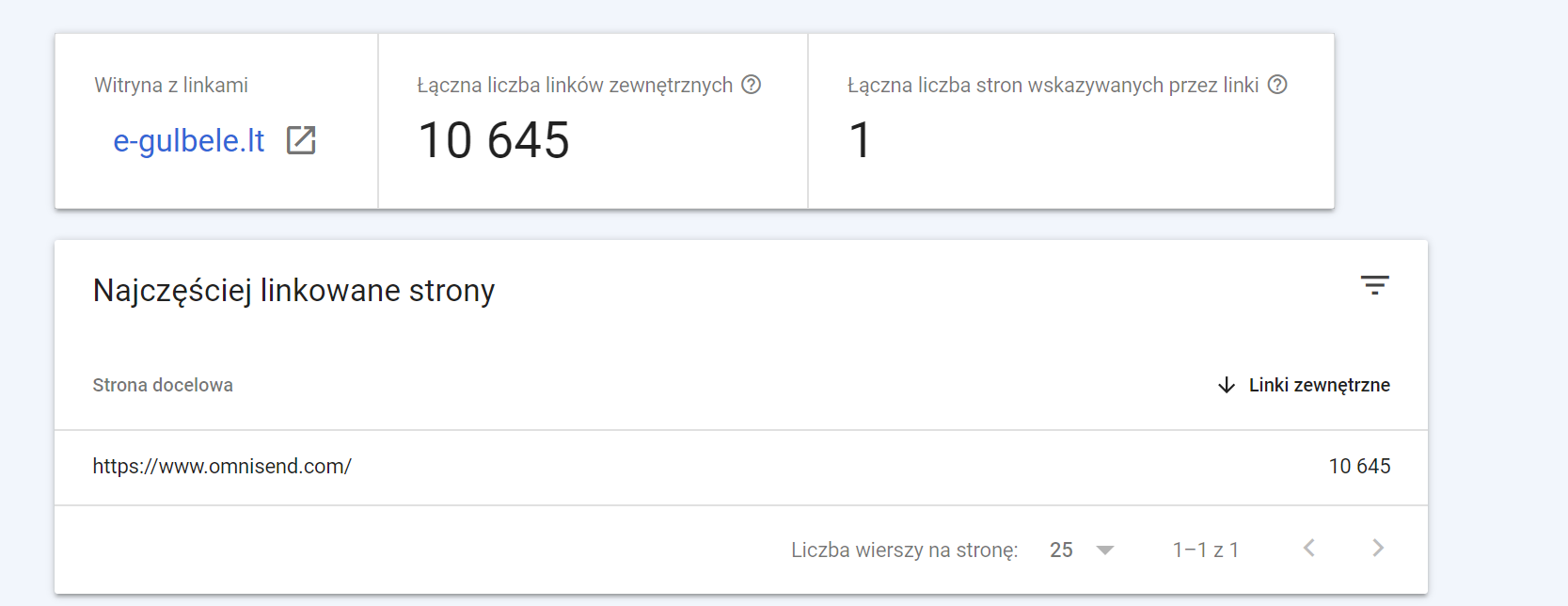
Another good but limited solution is to use the search engine directly and any of the available search operators. The typical process here is to select the sub-page of interest and use the command (example scheme) { URL without https and www} -site:https://domena.pl.
If we want to expand our research a bit and supplement what we analyze with additional data – it is worth using paid tools such as Ahrefs. After placing our domain, the tool will show all the links identified and stored in the database that lead to us. The disadvantage of this tool is that it can be blocked, not only classically in robots.txt or with a plugin, but also if it pretended to be Google.
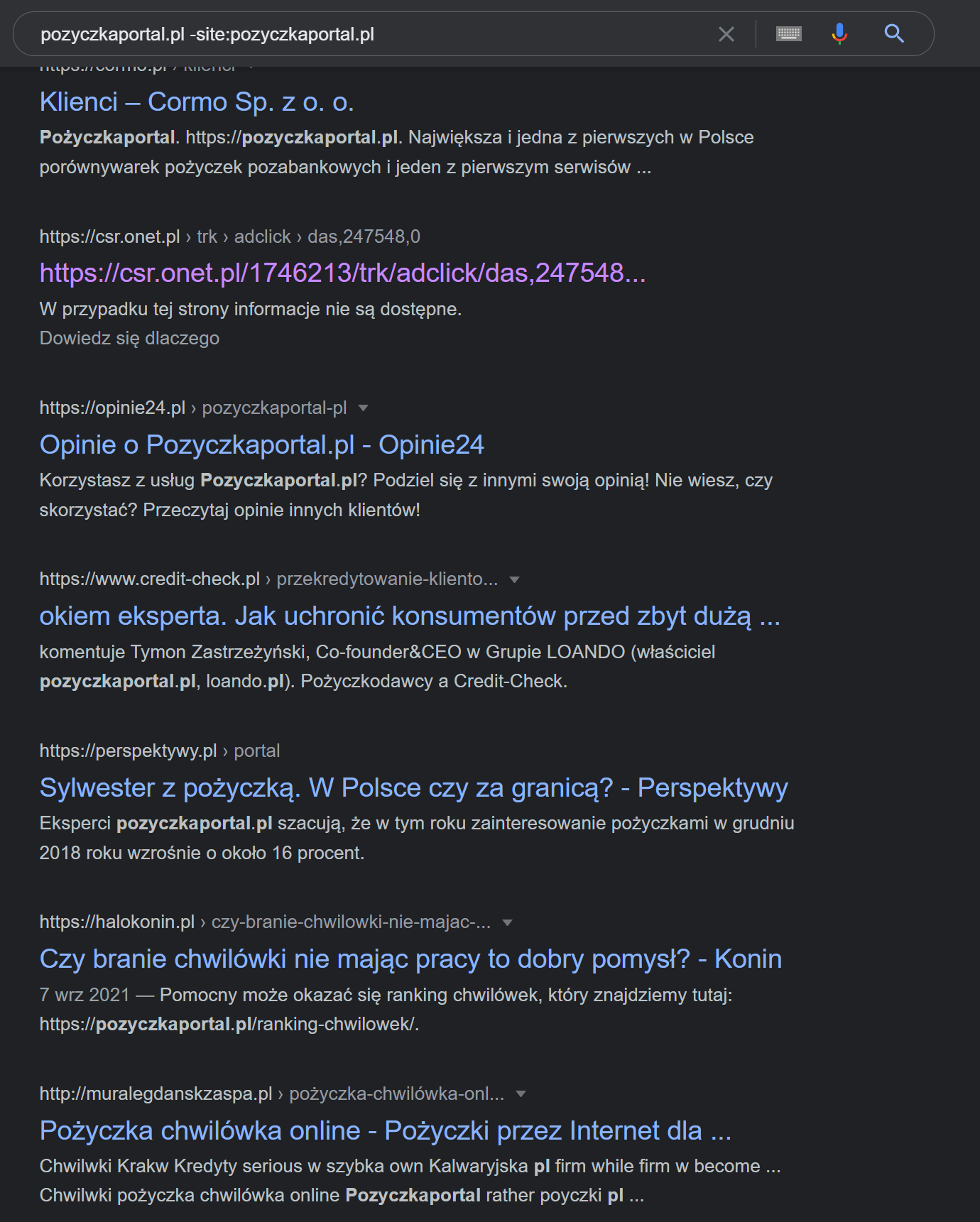
As part of our work with the tool, we can also check a lot of other information – which subpages are most popular with us in terms of the links that lead to them (knowledge of this can be used to stimulate internal linking):
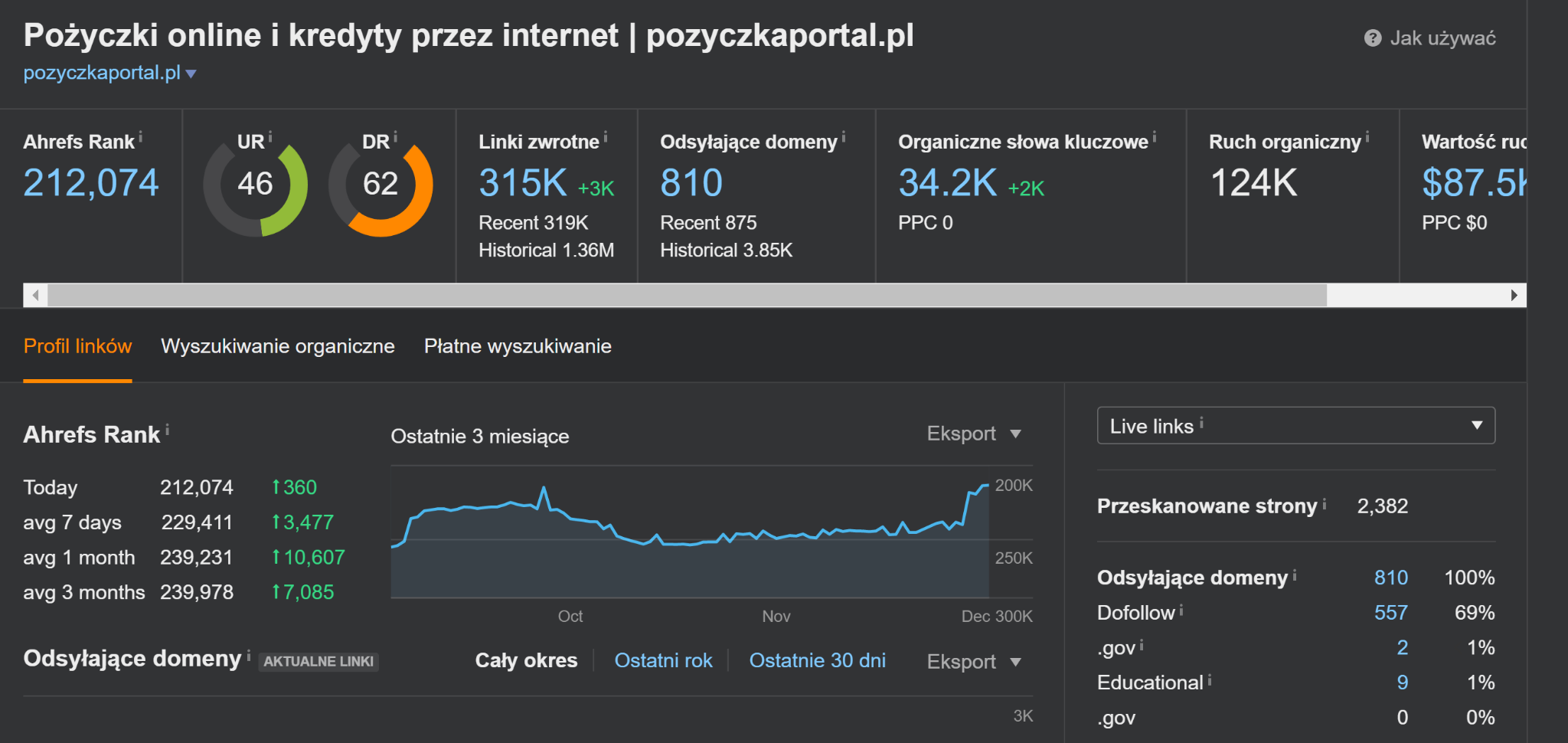
As part of our work with the tool, we can also check a lot of other information – which subpages are most popular with us in terms of the links that lead to them (knowledge of this can be used to stimulate internal linking):

Can you see your links in Google Analytics?
.
In theory, Google Analytics can also be an additional source of information about your site’s acquired links. The limitation here, however, is the need for traffic on individual links. We are talking about a situation where, after acquiring a link, users will click and go to our website. There are two reports in Google Analytics where we can discern what kind of links we have to the site:
1. source/medium and search referral:
 .
.
2 “Referral Sites” view:

As with Google Search Console, we won’t get information here about the SEO “power” of each referral – instead, we can see how many hits it generated and how qualitative the traffic was (time on site, rejection rate and, most importantly, the number of conversions). This data can be useful in the situation of off-page SEO activities.
How to analyze competitor links – typical process and tools
.
The process of analyzing competitor links is a complex process, because despite the availability of external tools, there is no guarantee that we will find/see all the links to a site.
This is due to the fact that SEO specialists investing a lot of money in, for example, SEO back-end strive to hide this fact from outsiders. This is normal practice for advanced projects in competitive industries, and even though in most cases such backlinks are findable in Google, it still makes it significantly more difficult to accurately analyze the links leading to the site.
To preview competitors’ links we can:
1. use Ahrefs, within which we can see not only how many links lead to the site and at what time they were acquired, but also juxtapose our domain with the competition and search for so-called link gaps, i.e. all the places from where the competition has links and from where we do not have links.
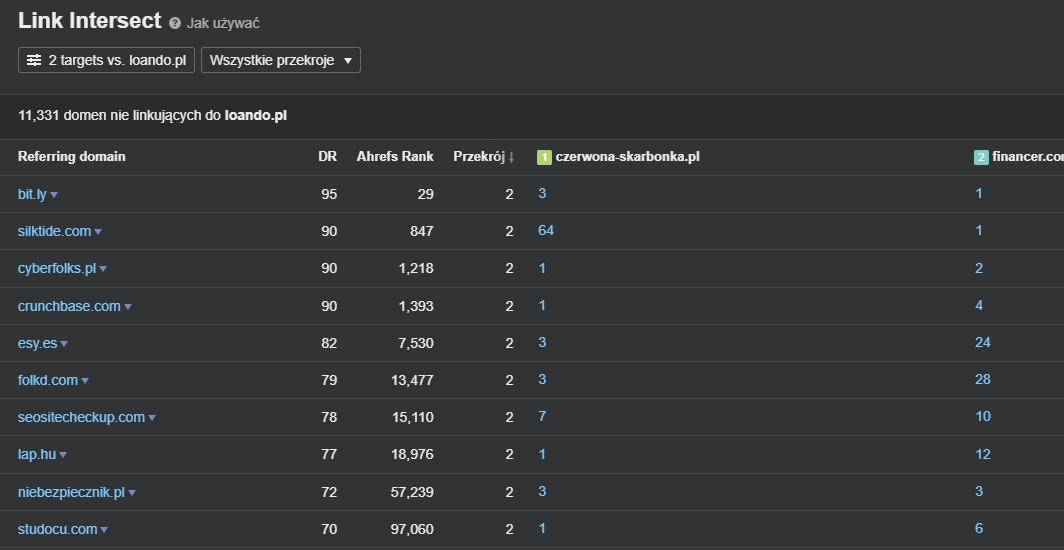 .
.
In many cases, when using Ahrefs, it’s also a good idea to check for 301 redirects to the site – in the past, this was a very popular method to hide real linking activity.
2. In competitive industries, it is also important to check the levels of link nesting (tiers) that I wrote about earlier. The Majestic tool will help us with this, where we get a beautiful-looking link graph.
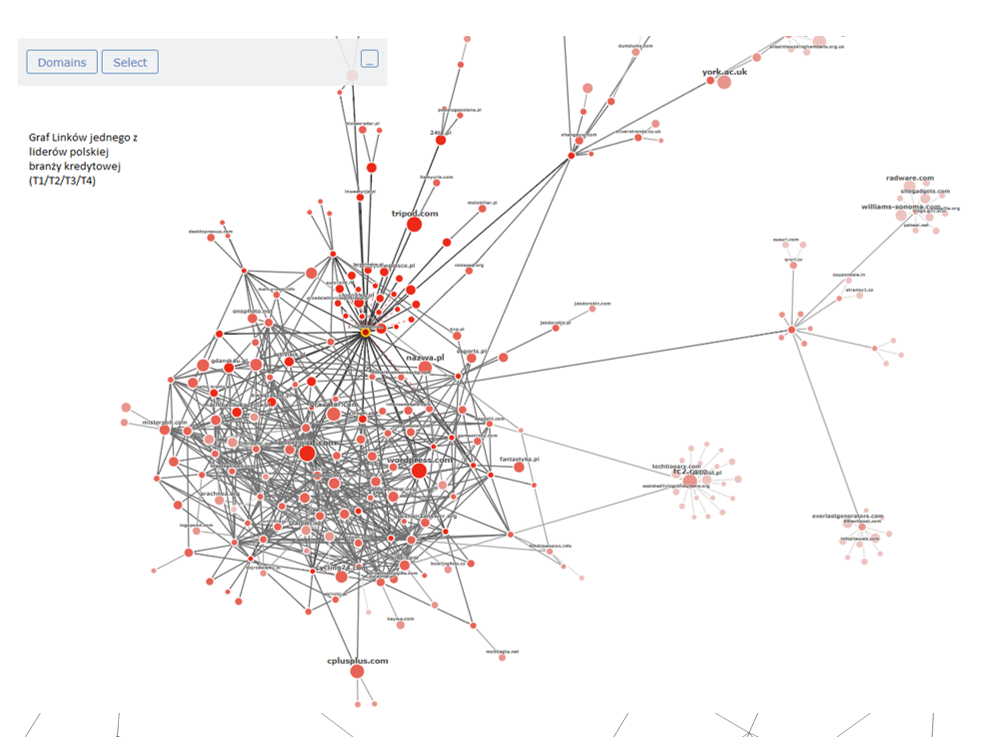 .
.
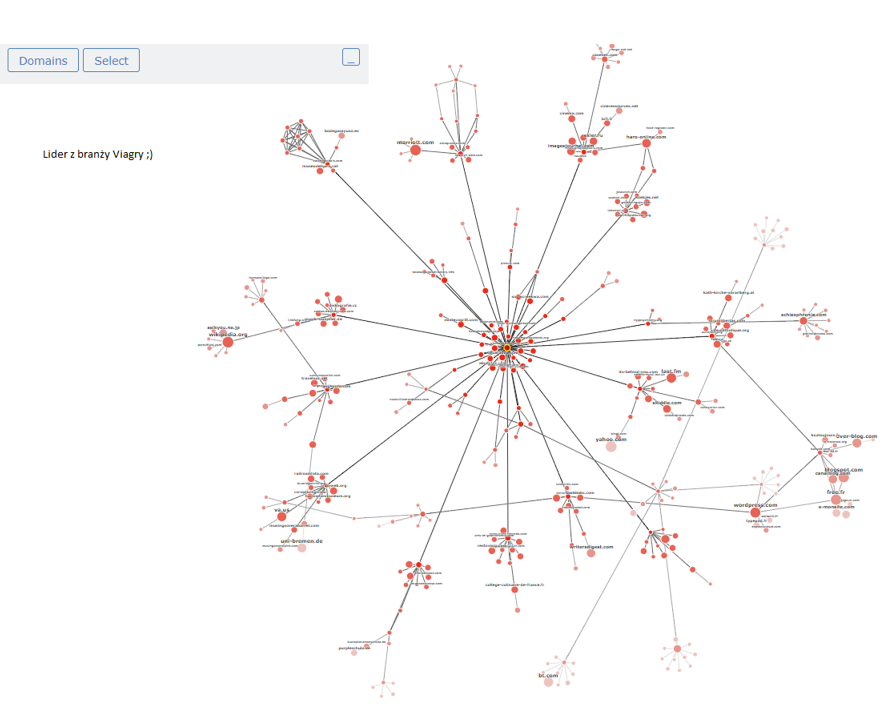
3. extracted from external tools data is not enough. It is a good idea to head to Google and, using search operators, look for occurrences of keywords or links of competitors. Using the search operators described earlier, we can look for referrals to the site that show up in Google. The whole process can be automated, for example, using the Scrapebox tool.
In case you track down your competitor’s links in the form of, for example, SEO backlinks, you can check what other sites are on that IP and whether they also link to your competitor’s site. To do this, we check ourselves first the DNS of the domain (to see if there is Cloudflare or not), and then having the IP address of the site at our disposal, we check what other domains can be found.
Analysis can be difficult if the site uses a CDN (Content Delivery System), because there is no physical information about what the site’s IP address is. In such a situation, the neighborhood may change, and additionally indicate domains completely unrelated to the competitor’s backend:
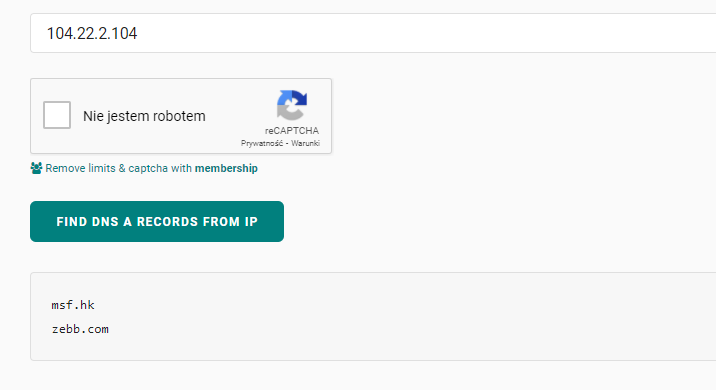 .
.
Analyze your competition for SEO – who is positioning themselves for what phrases and what positions they have in Google – you will do in turn in Senuto.
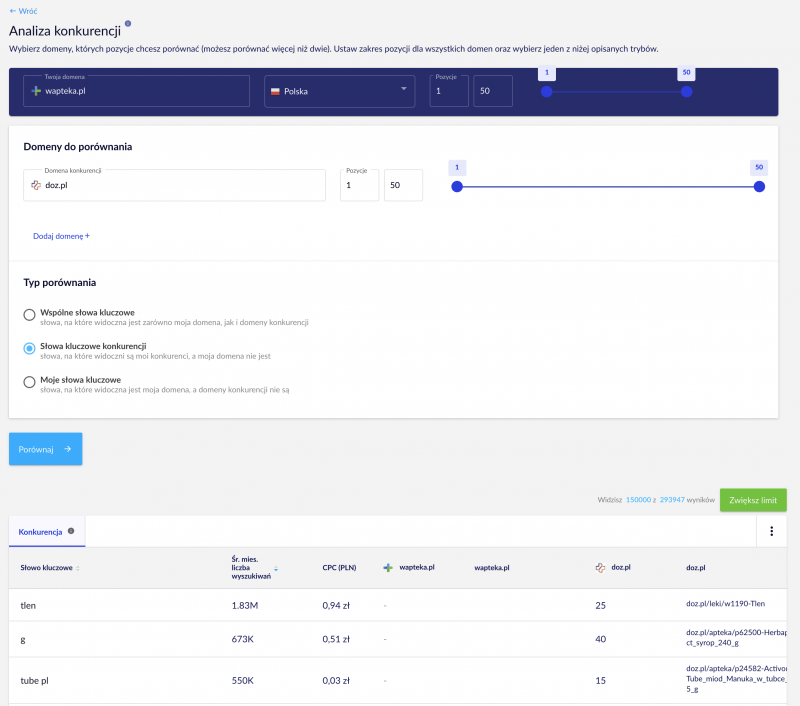 .
.
How many link analysis tools to use?
.
In fact, it all depends on the budget you have. ???? In theory, there is never enough data, although at some point the amount of data can be overwhelming. Especially since many tools present the same resources in a different way or the data can vary slightly. The basic set in link analysis is undoubtedly the trio: Google Search Console (for monitoring your links), Ahrefs and Google search results.
Strategies for getting links to a site
.
For the purpose of this post, I’ll do an overview of popular link acquisition methods. These are not the only possible ways, in addition, each method can be combined with another (not only linking directly to the site, but also stretching the whole activity on multiple levels depending on the competition or the idea of promoting the site).
Guest posting
.
This is perhaps one of the most popular methods of link acquisition, which historically (at the time of the Whitepress platform’s inception) was one of the primary tactics for any SEO specialist/website owner. The whole process involves selecting a site of interest due to its SEO parameters, ordering or publishing a custom article with a link, and you’re done.
Of course, guest posting can be implemented on your own, using manual outreach. The whole process involves searching for sites of thematic interest and contacting webmasters yourself to determine the cost of publication. The method is certainly cheaper for the end user, but labor-intensive – for this reason, few people in Poland opt for this method of link acquisition.
What to keep in mind when looking for sites for guest posts?.
-
- Thematicity is important – but not the most important. This means that if you have the opportunity to obtain a link from Onet.pl being the owner of a local transport company, it is worth taking such a link blindly.
.
-
- The ratio of outbound links to inbound links is a good indicator to estimate which publisher/owner cares about their domains, and which one has done is strictly for selling links.
.
-
- It’s worth making sure how guest posts are embedded in the structure of the site – if they aren’t linked internally, Google bot will have trouble navigating and indexing them.
.
-
- Domain Rating is an interesting indicator, but simple to manipulate.
.
- Better than the DR rating is to see how many competitors are already on it and whether the site has any fluctuation in organic traffic/visibility. If so, it may be a signal to us that it is not worth using it at the first level of linking.
Linking from existing entries
.
A method similar to acquiring guest posts, but (theoretically) cheaper. The whole idea is to find entries on the domain of interest in which we can add a link leading to our site. When re-indexing the entry, Google will discover and count the link directing to your website. For this method, it is worth paying attention to two parameters:
-
- the traffic and visibility on the entry from which we want to acquire the link
.
-
- its location/sublinking in the structure of the website
.
Theoretically, the most valuable entry is one that has a lot of internal links. You can check this using the Ahrefs tool and the “Internal Links” report.
Important: When linking from existing entries, it’s a good idea to use linking with images – this way you will not only get valuable links, but also real traffic to your website.
Whisper marketing (comments and forums)
.
A method considered rather budgetary and highly ineffective due to:
-
- the evisceration of online forums – many sites that used to provide a cool base for linking and reinforcing our activities most simply no longer exist.
.
-
- large spamming of outbound links – unfortunately, the world is not ready for Poles, so many Internet forums are simply a bot rally or cheap whisper marketing, where “Furniture Warsaw” talks to “Kitchens to size Katowice”.
.
-
- exclude outbound links – many forums do not allow links or tag them with new link attributes.
.
Web site directories/company directories
.
This is one of the constantly active methods of link acquisition, but few people admit to using it. Cataloging in SEO directories is regarded as a low-budget and highly artificial activity, for which Google has in the past sent notices about unnatural links through Google Search Console.
Nowadays, the aforementioned method works well on local queries, where it allows for effective diversification and, with a fully populated entry (contact information), allows to further strengthen the important issue of NAP (Name, Address, Phone number) in local positioning.
A branch of the aforementioned directories are business directories – not all of them allow links to our www, but are used to supplement the aforementioned NAP. In many niche industries, they additionally have very good organic visibility, which further drives traffic and potential conversions to our site.
Broken linkbuilding – link recovery to 404
.
A method extremely difficult to implement in Poland (no culture of adding links for free + often difficult contact with webmasters). It involves reviewing the outbound links of domains of interest from which we want to acquire links and making contact to swap the link for ours. To review all outbound links and what response code they return, we can use the Screaming Frog SEO Spider or Ahrefs tool.
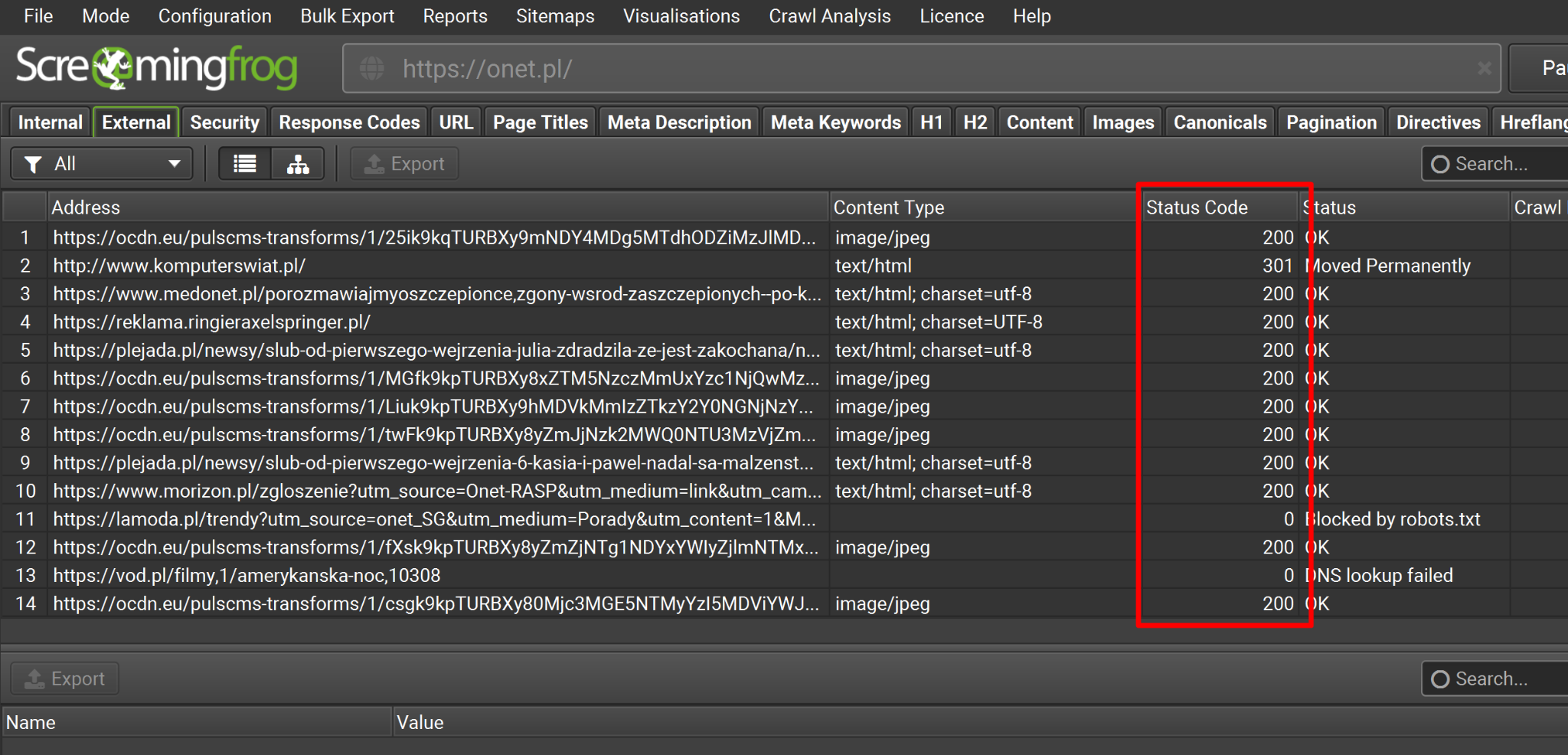
After finding subpages that direct to non-existing resources, we contact the webmaster to repair the link and replace it with a working (our) link.
As I mentioned earlier, the method although it seems simple and good – in implementation it is much more difficult.
Registration of 404 domains
.
Following the course of analyzing outbound links that correspond to 404, you can run the acquired list of domains through a registration availability checker, for example, using Ahrefs. Domains acquired in this way can be rebuilt and a really good quality SEO backend can often be erected on them.
PBN/SEO backend
.
Another method that was highly popular in the past, and is now undergoing a second youth, is the development and expansion of PBNs (Private Blog Networks). Known in Poland as SEO backlinks, this is a good method for expanding and managing your link profile over time. What to keep in mind when expanding your network of sites are:
-
- Easy management of multiple sites at once – it is necessary to have a panel that will allow you to update or publish new content on domains in bulk.
.
-
- A large number of IP addresses for the domains you own – while it is possible to calmly and successfully build a backend on one server/one address class, from the point of view of diversification and protection from competition/donations to Google it is reasonable to spread the domains over a dozen IP addresses.
- HTML sites are nice, but WordPress is easier to use.
.
-
- Linking between back-ends makes no sense – unless driven by chance.
.
- The best backend? On domains with history. These are often difficult and expensive to acquire, but they make sense.
Manual outreach for links
.
It would seem that the method is very simple to implement, while for Polish conditions it is quite labor-intensive. The complexity stems from the fact that contact with publishers is often difficult plus they are not interested in fulfilling a small number of orders.
One variation of manual research is to organize promotional actions and send gifts to bloggers in the topic of our site – theoretically we should get backlinks for this, of course, after proper encouragement. ????
Important: The method seems natural, but in the past Google has penalized one online florist who sent free gifs to bloggers in order to get mentions and links.
Linkbuilding with features – leverage your product
.
An extremely effective method of gaining links is to break your product into widgets and give away some of them for free, while smuggling a link to your website. This method is often used, for example, by livechat companies, where the information about who the solution provider is is also a link to the site.
How to approach this largely depends on what you are offering. In theory, any product or service can be dressed up in a widget given away for free. Are you in the business of brokering currency exchange? Make a widget with the current exchange rate and offer it for free to bloggers and financial services. The mechanism is simple and allows you to scale linkbuilding for yourself.
Purchase domains and 301 redirect to the target site
.
A method somewhat related to SEO back-end building – you acquire a domain that has historically contained links and content from a topic of interest, but instead of rebuilding the content you simply do a redirect to the target site.
However, it is worth remembering that:
- The 301 redirect works differently. If the content between domains is not relevant, it may take a little longer to transfer power.
- The process itself is worthwhile.
- The process itself is worth dividing into two parts:
- .
.
Part 1: we recover the content of the old domain, index it and let it “catch” organic traffic/visibility.
Part 2: we do a 301 redirect.
Important: For the patient, consider playing around with using rel=”canonical” instead of a 301 redirect.
Schemes in linking – hit or miss?
.
When analyzing your competitors’ activities or planning your activities, you are bound to come across the issue of schemes in linking. Schemes are common, although in the past more attention was paid to diversification and naturalness in terms of building a link profile.
Two popular schemes in linking are:
-
- Link pyramids – when two or more levels of links lead to your site, building a characteristic “pyramid.” Theoretically, this scheme is designed to strengthen the acquired links sequentially. The quality of links is arranged in such a way that the strongest quality links link directly to the positioned page. The lower in the pyramid, the lower the quality of the links. The main purpose of such pyramidal link building is to strengthen the links at each level (in the current reality, accelerating indexation), which ultimately is expected to translate into bigger and stronger increases in the positioned page.
.
-
- Link wheel – that is, a situation in which each page in the scheme links to the target page, but at the same time links among themselves.
- Link chains/referrals – a situation where we link not only to the target page, but also to other related links to the page. In this way, in theory, each link strengthens the next, but at the same time exposes our entire link profile to the gaze of competitors. Such a scheme is dangerous when sites sell links temporarily – the moment one link is removed, the SEO power of the acquired links is cut off.
.
-
- Linking only from homepages or only from entries.
.
The presence of schemes in the link profile is not a bad thing if the entire link profile is not reduced to a single model. To avoid unhealthy and dangerous schemes it is worthwhile:
-
- Make sure to diversify the types of links leading to the site – start SEO with competitor analysis and gather all possible links you want to acquire.
.
-
- Remember to link multiple times from one site to your site or related sites. It’s natural for one site to repeatedly refer to a site when writing about it.
.
-
- Don’t link from publicly accessible sites to your SEO background. There is nothing to expose yourself to the gaze of your competitors. However, it is worthwhile to link to publicly accessible sites from your SEO backend, thus building meaningful sub-linking, especially when our goal is to promote so-called brand assets (i.e. anything that relates to and builds the expertise of our brand).
.
Do the acquired links need to be indexed?
.
The overarching goal of link indexing is to get Google’s robot to visit a page with a link to us. Therefore, it is safe to assume that every link we acquire should be indexed so that Google’s robot will recalculate the link graph and “recalculate” the new link.
Important: For your own SEO background, it is worthwhile to conduct analysis on how often and when Google visits the site. This knowledge allows you to draw better conclusions about how much time passes between acquiring and indexing a link and the increase in position.
How to plan a link acquisition budget?
.
Planning what budget will be effective for link acquisition is a difficult task even for an experienced SEO specialist. The complexity comes from the fact that we cannot predict what algorithm changes Google will serve us.
When talking to clients, I like to say that money buys time. The bigger the budget for SEO efforts, the more options and “moves” we have in terms of link acquisition. The second point is that in SEO it’s all about systematicity. And while 500 zlotys a month won’t buy a lot of good links to a site, it’s certainly better some action than none.
The budgeting process itself in most cases looks like this:
-
- we determine what topic areas or keywords we want to position,
.
-
- we get all the competition for each keyword,
.
-
- Using Ahrefs we download information about what links our competitors have, and which are not in our profile. In this way, we complete for ourselves the link gap where it is possible and consider whether it is possible to acquire these links more cleverly.
.
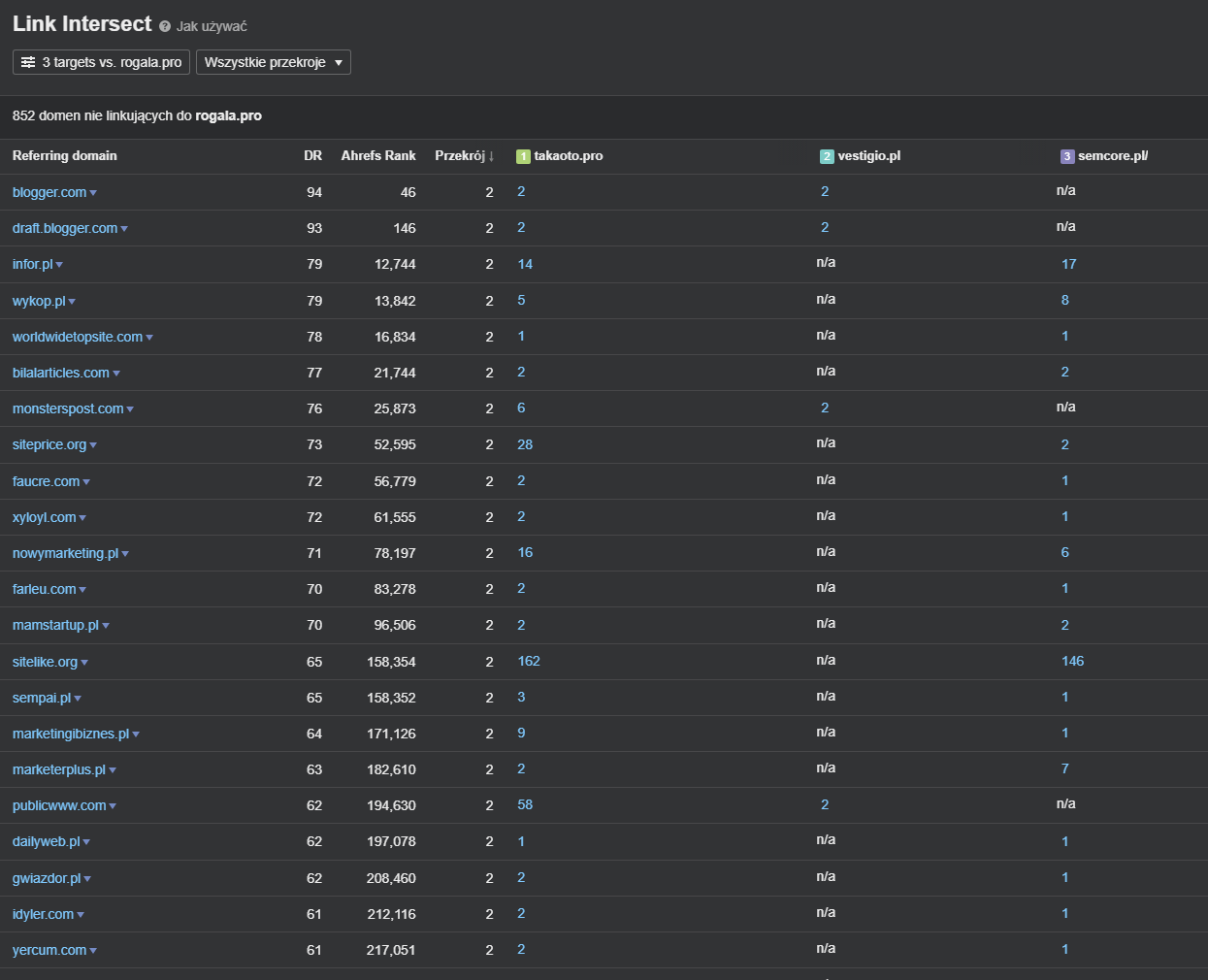
-
- Such obtained list we compare ourselves with the database of places at any of the intermediaries and price the cost of obtaining a link.
.
-
- Sources that we classify as free we price on the basis of the labor time needed to acquire a link. That is, if it takes us a week to acquire a link from a government site, the cost of that link, assuming an 8h work day, will be very high.
.
The real fun begins only now – having knowledge of the cost of the competitor’s link profile, we begin to look for opportunities to do something smarter. The link profile analysis shows that among the links acquired, many of them are sites that can be bought, but they are not sub-linked in any way. Therefore, I will spend half of the budget on the mere fact of appearing in the strongest places, and the other half on sublinking such acquired links over time.
Budget is one thing – testing space to another
.
What is missing when working with clients is space for testing, which would allow doing things wisely. I.e. in the process of long-term cooperation, it’s worth setting aside a bit of time to test the acquired links to the site, so that you don’t spend a whole lot of money on links that won’t translate into anything in the long run. However, this model of work requires a great deal of trust in the agency and partnership. As a result, the money spent generates a much better return in the long run.
Role of content in gaining links to a site
.
There are different schools of thought about the uniqueness of content. In our case, if we are aggressively acquiring links, we should absolutely aim for unique content, as this makes it more difficult for competitors to detect linking schemes. However, unique content in link acquisition is in no way a factor that improves your site’s chance of higher rankings in Google (looking from a purely SEO angle).
Linkbuilding in 2022 – what to expect?
.
I’d like to end the article with an omen about what might change in terms of linkbuilding in 2022. The times are unique – the pandemic, although no longer as heavily publicized on all sites, has left its mark on how we plan activities and spend money.
And it’s spending money that we need to tell ourselves most about. The thing about SEO is that the more popular a method is, the worse it works. Remember, it used to be that the non-obvious sites generated the best results, and as their popularity grew, they lost their importance.
What do I expect in 2022? Among other things, that there will be a revival of PBNs. We can already see that the story is coming full circle, and more and more people are talking about how “cool it would be to have their own facilities.” This increase in interest will certainly affect the price and availability of domains – so if you have long-term plans to build a network of backing sites, you’d better start buying domains now.
The last two years at Google have seen constant changes in how we understand web content separately from the link acquisition process. And while we had a minor finger threat in 2021 in terms of building links to a site, there was a lack of concrete impact. I think we’re in for a bit more “fun” in 2022 in terms of how Google will evaluate links.
Indexing is also a big challenge. Building traffic to online publications is especially important for brands operating heavily in off-page SEO. However, I believe that Google opening up to the IndexNow protocol will improve the process. However, this may involve new metrics that assess the quality of a site under indexing – after all, the search engine has already hit its ceiling and is looking to optimize the detected online resources.
 Łukasz Rogala
Łukasz Rogala